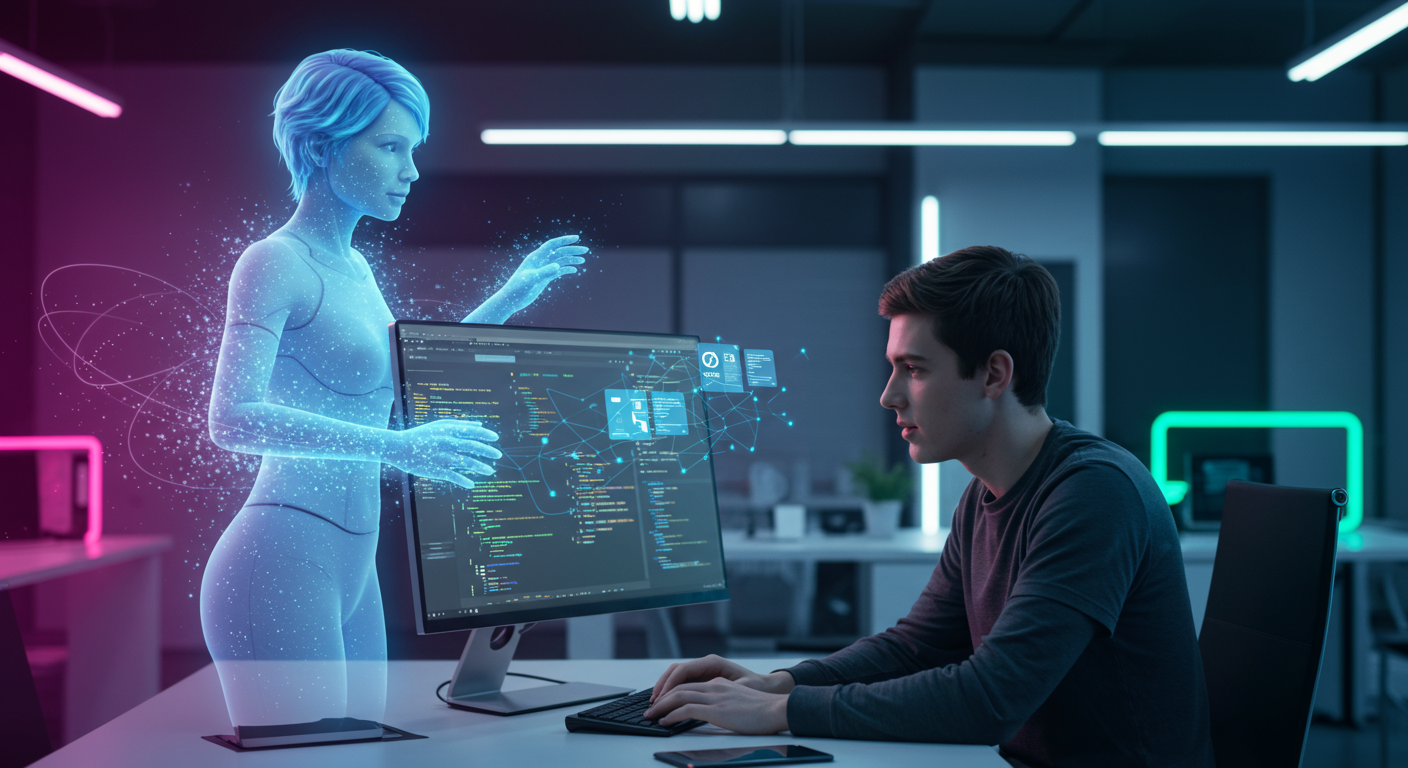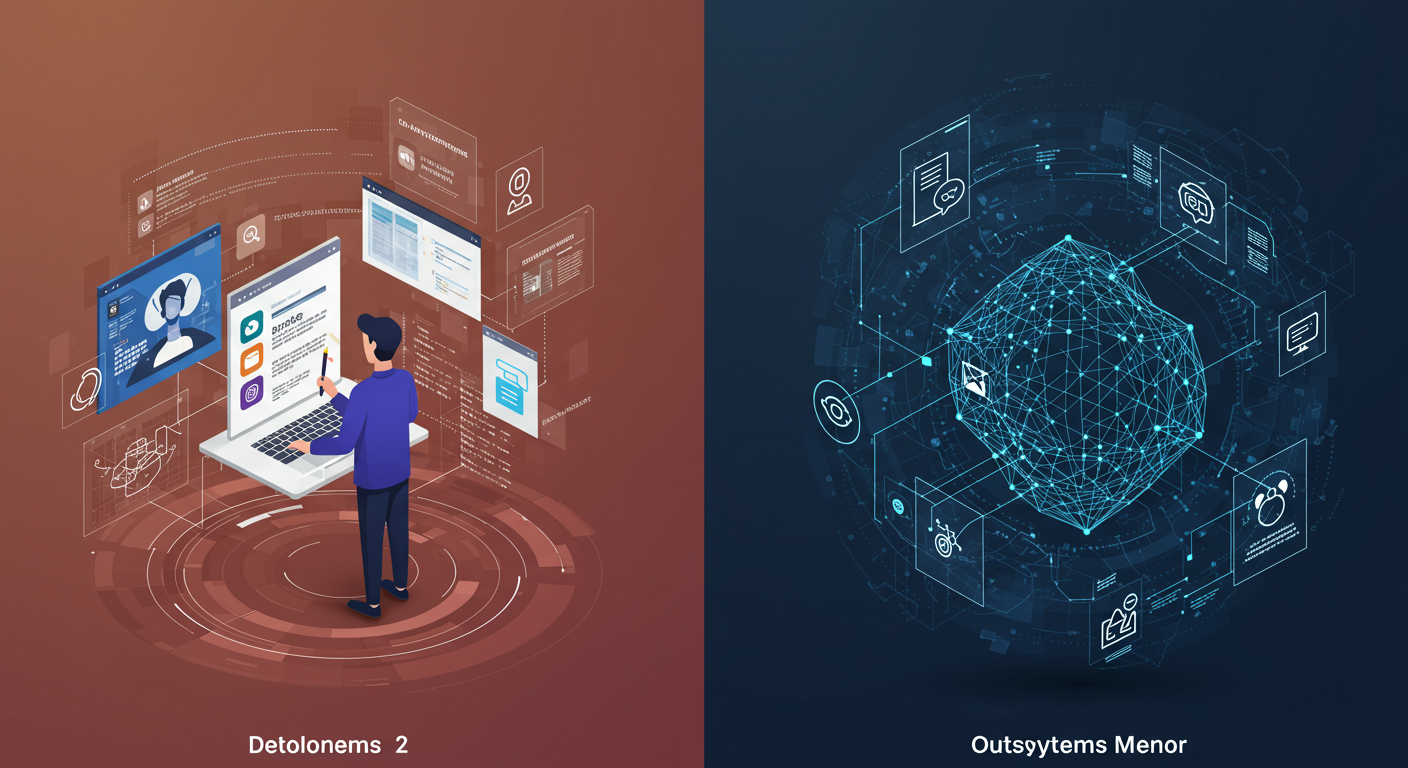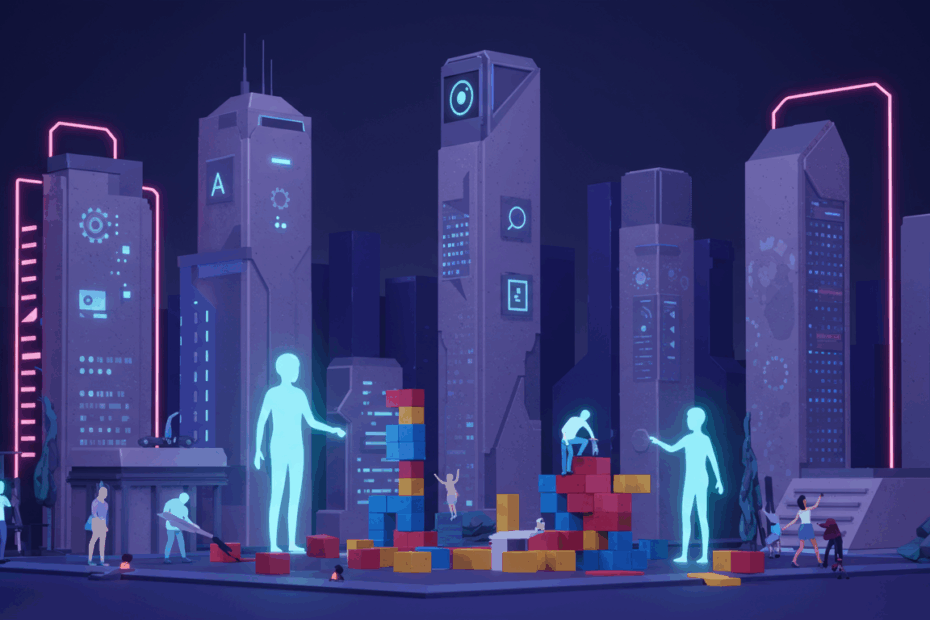The AI Co-Pilot for Your Entire Development Team: A Conversation on OutSystems Mentor
John: In the world of tech, we’re constantly chasing efficiency. For decades, software development has been a resource-intensive process, demanding highly specialized skills, long hours, and significant budgets. Businesses are under immense pressure to digitize and innovate, but they often hit a wall—a shortage of skilled developers, the crushing weight of maintaining old ‘legacy’ systems, and the difficult choice between building a custom solution from scratch or buying an off-the-shelf product that doesn’t quite fit. It’s a classic IT stalemate.
Lila: I’ve heard about that bottleneck. It feels like everyone wants a custom app, but very few have the resources for it. That’s where things like “low-code” come in, right? Can you break that down for our readers who might be new to the term? What does it actually mean?
John: Absolutely. Think of low-code as a middle ground between writing thousands of lines of complex code and using a simple website builder. Low-code platforms provide a visual environment where developers can drag and drop pre-built components, connect data sources, and define application logic without writing much traditional code. It dramatically speeds up the process. But now, we’re seeing the next evolution: a powerful fusion of low-code with generative AI. This is where tools like the new OutSystems Mentor are starting to change the game entirely.

So, What is OutSystems Mentor, Exactly?
Lila: Okay, “AI-powered low-code” sounds impressive. But what does a tool like OutSystems Mentor *do*? Is it like having a robot developer on your team? How does it fit into the picture?
John: That’s a great way to put it. Mentor is essentially an AI-powered digital assistant, or an “AI partner,” that’s integrated directly into the OutSystems development platform. It’s not just a simple chatbot that gives coding tips. It’s designed to assist across the entire software development lifecycle (often called the SDLC). It helps from the very first idea, to building the app, to testing it, and even to maintaining it long-term. It uses generative AI to understand what you want to build and then creates a functional, full-stack application as a starting point.
Lila: A full-stack application? So it builds the part users see—the front-end—and all the database and logic stuff behind the scenes—the back-end—all from a simple description? That sounds almost too good to be true.
John: It’s ambitious, but that’s the core value proposition. You can give Mentor a prompt, say, “Build me a customer support ticket system,” and it will generate the user interface for submitting tickets, the data model for storing customer and ticket information, and the basic business logic to get it all working. It’s designed to handle the heavy lifting, so developers can focus on refining and customizing the application rather than starting from a blank page.
Supply and Platform: Where Does Mentor Live?
Lila: You mentioned it’s “integrated into the OutSystems platform.” What is that platform? Is it something you download, or is it a web service? I think understanding the foundation is key here.
John: An excellent point. Mentor operates within the **OutSystems Developer Cloud (ODC)**. ODC is the company’s modern, cloud-native low-code platform. Think of it as the factory where you build and run your applications. It’s a fully managed service, meaning OutSystems handles all the underlying infrastructure, servers, and databases in the cloud. Developers just log in through their web browser or a desktop tool called ODC Studio and start building.
Lila: So ODC is the entire ecosystem, and Mentor is the AI genius that lives inside it, helping you work faster and smarter within that ecosystem?
John: Precisely. This integration is crucial. Because Mentor is part of ODC, it has full context of everything happening on the platform. It can see your other applications, your existing data structures, and your security roles. This allows it to provide highly relevant, context-aware suggestions, which sets it apart from standalone AI coding tools that have no idea about your specific company’s environment.
The Technical Mechanism: How Does the Magic Happen?
Lila: Okay, let’s get into the nitty-gritty. How does it work under the hood? You said it’s not just a ChatGPT wrapper. What technologies are powering Mentor to make it so context-aware and capable?
John: This is where it gets really interesting. Mentor is a sophisticated blend of several AI technologies working in concert. Let’s break them down:
- Generative AI & Large Language Models (LLMs): At its core, it uses powerful LLMs, similar to what powers tools like ChatGPT or Gemini. This is what allows it to understand natural language prompts (the instructions you give it in plain English) and generate application code and structures.
- Machine Learning (ML): Beyond just generation, Mentor uses ML models that are specifically trained on the OutSystems platform and best practices. It analyzes patterns from millions of anonymized applications to learn what makes a good, secure, and scalable app. When it suggests an improvement, it’s drawing on this vast knowledge base.
- Contextual Awareness: This is its secret weapon. When you ask it to build something, it doesn’t just look at your prompt. It scans your existing ODC environment to identify relevant entities. For example, if you ask for an “order management app” and you already have a “Customer” and “Product” application, Mentor will intelligently suggest connecting to those existing data models instead of creating new, duplicate ones. This prevents data silos and reduces what we call ‘technical debt.’
- Retrieval-Augmented Generation (RAG): This is particularly important for a feature called the AI Agent Builder. RAG is a technique that allows the AI to access and use a specific, private knowledge base—like your company’s internal documents or product manuals. So, when you build a customer service AI agent, it can provide answers based on your actual, proprietary data, not just generic information from the internet. This makes the AI agents far more accurate and trustworthy.
Lila: Wow, so that RAG technology means the AI isn’t just “hallucinating,” or making up answers. It’s grounded in the company’s own reality. And the contextual awareness sounds like the biggest differentiator from a general-purpose tool like GitHub Copilot, which might suggest code but doesn’t understand the larger architectural picture of your company’s software ecosystem.
John: You’ve hit the nail on the head. Copilot is an excellent assistant for a developer writing code line-by-line in a file. Mentor is positioned as an assistant for the architect and the development team, thinking about the entire application and how it fits into the enterprise landscape. It’s about building correctly from the start, with governance and maintainability built in.

Team and Community Behind the Tech
Lila: This feels very cutting-edge. Is OutSystems a new startup that just jumped on the AI hype train, or do they have a history in this space?
John: That’s a fair question. OutSystems is actually a veteran in the low-code market. They were founded back in 2001, long before “low-code” was a popular buzzword. They’ve spent over two decades building a robust platform for enterprise-grade application development. This history is important because it means their platform is mature, secure, and tested by thousands of large companies worldwide. Mentor isn’t an afterthought; it’s the next logical layer of intelligence built on top of a very solid foundation.
Lila: So they have experience. What about the community? If a developer gets stuck, is there a place to get help?
John: The community is one of their biggest strengths. They have a very active global community of developers with forums, detailed documentation, and free online courses. They host regular events and have a marketplace called the OutSystems Forge, where developers can share and download reusable application components, connectors, and templates. So, while Mentor is there to help, you also have a massive human network to rely on.
Use-Cases and the Future Outlook
John: In terms of practical application, the use-cases are broad. We’re seeing companies use it for:
- Internal Business Process Automation: Building apps for things like employee onboarding, expense approvals, or inventory management quickly.
- Customer-Facing Portals: Creating secure portals for customers to track orders, manage their accounts, or access services.
- Legacy System Modernization: Instead of a multi-year, high-risk project to rewrite an old system, they can use Mentor to rapidly generate a modern, cloud-based version and then have developers focus on migrating the complex business logic.
- Rapid Prototyping: Business teams can describe an app idea and get a working prototype in minutes or hours, not weeks. This allows them to validate ideas with real users before committing significant resources.
Lila: That prototyping use-case is huge. It sounds like it could really bridge the communication gap between the business side and the IT side. But looking forward, where does this go? Will developers even be necessary in ten years if the AI can build everything?
John: That’s the billion-dollar question. The vision isn’t to replace developers but to elevate their role. The AI handles the repetitive, tedious work—the “grunt work”—of setting up databases, building standard screens, and checking for common errors. This frees up the human developer to be the architect, the creative problem-solver, and the orchestrator who focuses on the complex, unique business challenges that the AI can’t solve on its own.
Lila: So developers become more like strategists? And what’s the next step for the AI itself?
John: The next step is a move towards what the industry is calling “AI agents” or “agentic AI.” Today, Mentor is an assistant that makes suggestions and follows commands. The future vision is for autonomous AI agents that can take on entire business processes. For example, an AI agent could monitor sales data, identify a dip in a certain region, automatically spin up a targeted marketing campaign by integrating with other systems, and then report on the results. Mentor and the AI Agent Builder are the foundational steps toward that more autonomous future.

How Does It Stack Up? A Competitive Comparison
Lila: This all sounds very powerful, but I’m sure other companies are working on similar things. How does OutSystems with Mentor compare to other major players? For example, what about Microsoft’s Power Apps or other low-code platforms like Mendix?
John: It’s a competitive space, for sure. Let’s break it down:
- vs. Other Low-Code Platforms (Mendix, Microsoft Power Platform): Many platforms are incorporating AI. Microsoft has its Copilot integrated across the Power Platform, which is very powerful for helping build apps and automate workflows. The key differentiator OutSystems is pushing for with Mentor is the focus on the *entire* SDLC within a single, cohesive tool. Mentor isn’t just about generating the app; it’s also about the AI-powered code reviews, security scans, and architectural validation *after* it’s built. They are betting on this holistic, governed approach to be a major advantage for building complex, mission-critical enterprise applications.
- vs. Standalone AI Code Assistants (GitHub Copilot, Amazon CodeWhisperer): This is a different category. Tools like Copilot are fantastic for professional developers working in traditional code editors like VS Code. They suggest code snippets and can complete functions. However, they lack governance. They can produce code that might be insecure, inefficient, or doesn’t fit the company’s architectural standards. Mentor, working within the governed OutSystems platform, generates applications that are, by design, compliant with the platform’s best practices for security, performance, and architecture. It’s about building a well-structured house versus getting suggestions on how to place individual bricks.
Lila: So, it’s a trade-off between the pure flexibility of traditional code with an AI assistant, and the speed, security, and architectural consistency of an integrated AI-powered low-code platform. The choice depends on what you’re trying to build.
John: Exactly. For a small, standalone script or a highly specialized algorithm, a tool like Copilot is perfect. For a complex enterprise system that needs to be secure, scalable, and easy to maintain for years to come, the integrated platform approach has compelling advantages.
Risks, Cautions, and What to Watch For
Lila: This can’t all be sunshine and roses. What are the potential downsides or risks of going all-in on a platform like this? What should a company be cautious about?
John: It’s crucial to look at this with a critical eye. No technology is a silver bullet. The main considerations are:
- Vendor Lock-in: When you build your core applications on any single platform, it can be difficult and costly to move away from it later. This is a classic strategic risk with any specialized platform, not just OutSystems.
- Cost: Enterprise-grade platforms are not cheap. While they can save money in development time and resources, there is a significant licensing cost. Organizations need to do a thorough Total Cost of Ownership (TCO) analysis.
- The “Last Mile” Problem: While AI and low-code can get you 90% of the way there, very complex or unique requirements might still need custom code or clever workarounds. You still need skilled developers who understand the platform deeply to solve these hard problems.
- Human Oversight is Non-Negotiable: You cannot blindly trust what the AI generates. A recent study OutSystems themselves cited found that 62% of IT pros are concerned about security with AI-generated code. Developers must still review, test, and understand the applications Mentor builds. It’s an assistant, not an infallible oracle.
Expert Opinions and Industry Analysis
Lila: What’s the general vibe from the tech world? Are analysts and other journalists seeing this as a genuine shift or just incremental improvement?
John: The consensus is that this is a significant evolution. The integration of generative AI directly into the development lifecycle is seen as a direct response to the biggest challenges IT departments face today: the talent shortage and the pressure to deliver faster. Analysts point out that by embedding AI in a governed, low-code environment, OutSystems is addressing the primary fears around generative AI in the enterprise—namely, the risks of creating insecure, unmaintainable, or “shadow IT” applications. The focus is on “AI-powered, human-governed” development.
Lila: So the narrative is that it’s “safe AI” for the enterprise, designed to augment developers, not just generate wild code?
John: That’s the core message, and it seems to be resonating. It’s a pragmatic application of AI, aimed at solving real-world business problems like reducing backlogs and managing technical debt, which is a message that resonates with CIOs and IT leaders.
Latest News and Roadmap
Lila: So, what’s the current status? Is Mentor fully rolled out? What’s next on the roadmap for OutSystems’ AI ambitions?
John: OutSystems introduced Mentor in late 2024, and it is a central feature of the OutSystems Developer Cloud (ODC). It’s being actively developed and enhanced. The roadmap they’ve shared points clearly towards more autonomy. They are heavily investing in the AI Agent Builder, with the goal of enabling businesses to create those intelligent, conversational agents that can be embedded in any application. The long-term vision is to evolve Mentor from a reactive assistant to a proactive partner that can anticipate needs and even manage entire workflows. We’re still in the early innings, but the direction is clear: more intelligence, more automation, and more power into the hands of developers.
Frequently Asked Questions (FAQ)
Lila: Let’s wrap up with a quick FAQ section for our readers who might have some lingering questions.
John: Great idea. Let’s tackle a few common ones.
Lila: First: Is this “no-code” or “low-code”? Can a total non-technical person use it to build a complex app?
John: It’s firmly in the **low-code** camp. While a business user could use Mentor to generate a simple prototype, building, securing, and integrating a true enterprise-grade application still requires the skills of a developer. It makes developers hyper-productive; it doesn’t replace them.
Lila: How secure are the applications built with Mentor?
John: Security is a core focus of the platform. Because Mentor operates within the ODC, the applications it generates automatically inherit the platform’s built-in security features. Furthermore, Mentor’s AI-powered code analysis continuously scans for potential vulnerabilities, helping teams maintain a strong security posture.
Lila: Can it connect to my company’s existing databases and software, like Salesforce or SAP?
John: Yes. The OutSystems platform has robust integration capabilities. It offers pre-built connectors for many popular systems and allows developers to easily build custom integrations to legacy systems or any other service with an API (Application Programming Interface).
Lila: What kind of applications is it *not* good for?
John: It’s not the ideal tool for building things like high-frequency trading algorithms, graphically-intensive AAA video games, or low-level operating system drivers. It’s optimized for building business applications—the systems that run a company.
Related Links and Further Reading
John: For those who want to dive deeper, we recommend checking out these resources:
- The Official OutSystems Website
- The OutSystems Developer Community Forums
- InfoWorld and other tech publications for analyses on low-code and AI development
Lila: This has been incredibly insightful, John. It feels like we’re at a real turning point. The idea of describing an application in plain English and having a functional, secure foundation appear in minutes is genuinely transformative. It’s exciting to think about what developers will be able to create when all that initial, repetitive work is taken care of for them.
John: I agree completely. It’s not about removing the human element, but about amplifying it. By pairing human creativity and strategic thinking with the raw power and speed of AI, we’re opening up a new era of software innovation. The future of development is less about syntax and more about solutions.
Disclaimer: This article is for informational purposes only and should not be considered financial or investment advice. The technology landscape is constantly changing. Always conduct your own thorough research (DYOR) before adopting any new platform or technology.
